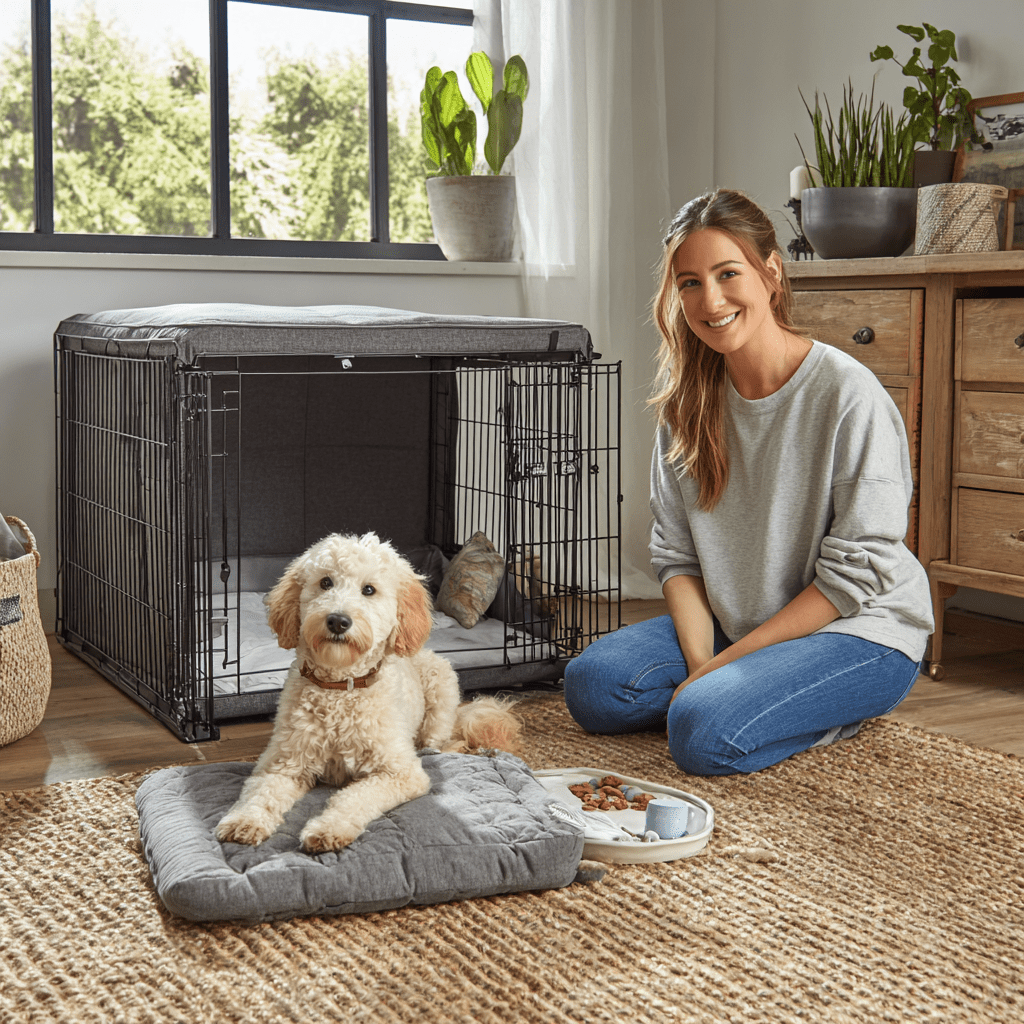Introduction
Crate training can be one of the most valuable tools in a dog owner’s toolkit—but only if done right. For many pet parents, the word “crate” might bring images of confinement. In reality, a properly introduced crate becomes a dog’s safe haven. This guide will walk you through the gentle and effective process of crate training your dog without stress—for both of you.
1. Why Crate Training Matters
Crate training has several benefits when implemented thoughtfully:
- Safety: Keeps your dog secure when unsupervised.
- Housetraining: Dogs naturally avoid soiling their sleeping space.
- Travel: Eases transitions for car rides and vet visits.
- Recovery: Helps post-surgery care or illness recovery with reduced stress.
- Personal Space: Dogs love having a den-like space to relax in.
However, none of this matters if your dog associates the crate with fear. Let’s change that.
2. Choosing the Right Crate
Before you start, invest in the right type of crate:
- Size: The crate should be big enough for your dog to stand, turn, and lie down—but not too large.
- Material: Wire crates are versatile; plastic crates offer more privacy.
- Additions: Include a soft mat, a favorite toy, and a water bowl.
A cozy setup encourages your dog to explore without pressure.
3. Introducing the Crate: Slow and Steady

The key to crate training without stress? Go slow.
Step-by-Step Introduction:
- Day 1: Place the crate in a quiet corner of your living space with the door open. Let your dog sniff and explore it freely. Toss treats inside.
- Day 2-3: Start feeding your dog near the crate, gradually moving the bowl inside.
- Day 4+: Encourage short, voluntary entries with praise and rewards. Never force your dog in.
Use cues like “crate” or “home” to build a positive association.
4. Crate Time with the Door Closed
Once your dog enters the crate comfortably:
- Step 1: Gently close the door for a few seconds. Open before they get anxious.
- Step 2: Increase the duration gradually, always paired with treats and praise.
- Step 3: Stay nearby initially, then start walking away for short intervals.
Consistency and calm energy from you reduce your dog’s anxiety.
5. Crate Training Schedule
Dogs thrive on routine. Establish a daily crate schedule:
| Time | Activity |
|---|---|
| Morning | Potty, breakfast, crate time |
| Mid-morning | Play, short crate nap |
| Afternoon | Walk, training, crate break |
| Evening | Dinner, family time, crate sleep |
Don’t leave your dog in the crate for more than a few hours during the day (especially puppies). Always provide bathroom breaks.
6. What to Do If Your Dog Cries in the Crate
Crying is normal at first—but don’t rush to open the crate.
- Assess: Have they gone potty? Is it too long between breaks?
- Stay Calm: Avoid shouting or scolding.
- Ignore Attention-Seeking: Reward calm behavior instead.
- Soothing Tools: Use white noise, soft toys, or a blanket over the crate.
Patience and consistency help your dog understand that whining won’t get them out.
7. Common Mistakes to Avoid
- Using the crate as punishment
- Moving too fast
- Leaving your dog crated for too long
- Not rewarding calm crate behavior
Crate training should always feel rewarding and safe—not isolating.
8. Crate Training for Puppies vs. Adult Dogs
Puppies:
- More frequent potty breaks
- Can learn quickly with consistency
Adult Dogs:
- May have previous negative experiences
- Require more time and patience
Older rescues can be crate trained successfully with positive reinforcement.
9. Gradually Increasing Alone Time
Once your dog is comfortable being in the crate:
- Leave the room for 5–10 minutes.
- Build up to longer absences (30–60 minutes).
- Eventually leave the house for short errands.
Always return calmly, without fanfare, to normalize comings and goings.
10. When to Crate and When Not To
✅ Ideal times for crate use:
- During rest periods
- While unsupervised
- For travel or vet visits
🚫 Avoid crating when:
- As a punishment
- For excessive hours during the day
- If your dog shows signs of crate distress
Balance is key. The crate is a tool, not a lifestyle.
Conclusion
Crate training doesn’t have to be stressful. With a gentle, positive approach, your dog can learn to love their crate as a safe, comfortable retreat. Remember: every dog is different, and patience will always pay off.
Whether you’re housetraining a new puppy or helping a rescue feel safe, crate training is one of the kindest ways to support their well-being—if done with empathy and care.
